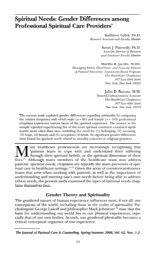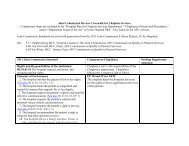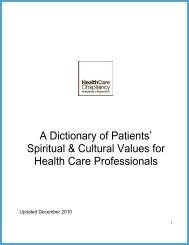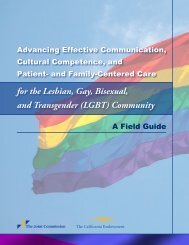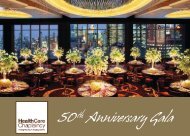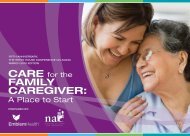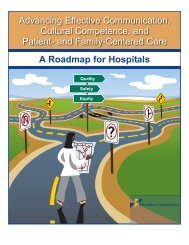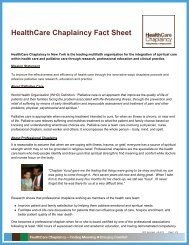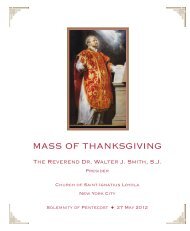The Beacon Winter 2002 - HealthCare Chaplaincy
The Beacon Winter 2002 - HealthCare Chaplaincy
The Beacon Winter 2002 - HealthCare Chaplaincy
Create successful ePaper yourself
Turn your PDF publications into a flip-book with our unique Google optimized e-Paper software.
WINTER <strong>2002</strong><br />
INSIDE<br />
<strong>Beacon</strong><br />
<strong>The</strong><br />
News from <strong>The</strong> <strong>HealthCare</strong> <strong>Chaplaincy</strong> – A Multifaith Center for Pastoral Care, Education & Research<br />
Wholeness of Life Award Recipients<br />
Honored in Partner Healthcare Institutions<br />
Honorees Celebrate with <strong>Chaplaincy</strong> Trustees, Colleagues, Family, and Friends<br />
3<br />
Using Your Retirement Plan<br />
for Charitable Giving<br />
“This was the highlight of my year!” said<br />
<strong>Chaplaincy</strong> trustee Charles Crane. Mr. Crane<br />
presented the Wholeness of Life award to Jason<br />
Zimmerman, a clinical oncology nurse at<br />
Memorial Sloan-Kettering Cancer Center.<br />
4<br />
<strong>The</strong> Wholeness of Life<br />
Awards Dinner:<br />
A Gathering of Friends<br />
Like all of this year’s honorees, Mr. Zimmerman<br />
was honored in a special award celebration in the<br />
partner healthcare institution in which he works.<br />
<strong>The</strong> Wholeness of Life awards, which recognize<br />
patient care professionals for their compassionate<br />
work in caring for the whole person, were presented by a <strong>Chaplaincy</strong> trustee<br />
and a senior member of <strong>The</strong> <strong>Chaplaincy</strong>’s administration in local ceremonies<br />
with the recipients’ administrators, colleagues, and families.<br />
Lenox Hill honoree Michael Conroy (second<br />
from right) is joined by <strong>Chaplaincy</strong> life<br />
trustee William Spears (far right); Lenox<br />
Hill pastoral care staff (from far left)<br />
Rabbi Ralph Kreger, Imam Yusuf Hasan,<br />
the Rev. Dr. John Bucchino, and the Rev.<br />
Melody Meeter; and <strong>Chaplaincy</strong> director of<br />
clinical services the Rev. George Handzo.<br />
“<strong>The</strong>re was such a warmth, a real genuine<br />
appreciation for this man,” said Sr.<br />
Rosarine Quinn, staff chaplain at New York Hospital Medical Center of<br />
Queens, of the hospital’s honoree John Petrie. As vice president for clinical<br />
services, Mr. Petrie is well known and loved among hospital staff.<br />
(continued on page 8)<br />
<strong>The</strong> Rev. Canon George Brandt, <strong>Chaplaincy</strong> trustee, presents<br />
the Wholeness of Life award to Dr. Crisanta Mosende-Reyes,<br />
North General Hospital’s honoree<br />
HEALING TOUCH By David B. Case, M.D.<br />
<strong>The</strong> Meaning in Touch<br />
What does it mean for one person to touch another? Touching, even by shaking hands, is a complex form of<br />
human connection that derives its meaning from the context in which it happens. <strong>The</strong> context could be social<br />
introduction, expression of affection, medical examination, and of course many others. Touching is a gesture of<br />
intimacy that is accompanied by some sort of feeling: warmth, comfort, trust, or even an expression of love.<br />
Dr. Lewis Thomas, the legendary teacher at Memorial Sloan-Kettering Cancer Center wrote:<br />
“Some people don’t like being handled by others, but not, or almost never, sick people. <strong>The</strong>y need being touched, and part of the<br />
dismay in being very sick is the lack of close human contact. Ordinary people, even close friends, even family members, tend to<br />
stay away from the very sick, touching them infrequently as possible for fear of interfering, or catching the illness, or just for fear<br />
of bad luck. <strong>The</strong> doctor’s oldest skill in trade was to place his hands on the patient.”<br />
(continued on page 6)<br />
www.healthcarechaplaincy.org
A Message from the Rev. Dr. Walter J. Smith, S.J., President & CEO<br />
“<br />
At the conclusion of a fundraising<br />
committee meeting a trustee handed<br />
me several pages that he had<br />
photocopied from chapter 8 of a new book by<br />
Wayne Teasdale entitled: A Monk in the World:<br />
Cultivating a Spiritual Life (New World Library,<br />
<strong>2002</strong>). For the past sixteen years Teasdale, a Roman<br />
Catholic layman, has been living as a monk outside a<br />
monastery, attempting to integrate the wisdom of<br />
many religious traditions with his own Christianity.<br />
Our trustee had checked a section for special attention<br />
subtitled, “Illness as a journey to wholeness.” I<br />
Remember your humanity<br />
and forget the rest…<br />
folded the pages and put them in the inner pocket of<br />
my jacket and rushed across town to attend a reception<br />
celebrating the opening of the exhibition<br />
“Einstein” at the American Museum of Natural<br />
History. <strong>The</strong> final letter Einstein wrote before his<br />
death in 1955 was addressed to Bertrand Russell, the<br />
English mathematician and philosopher with whom<br />
he was collaborating in a campaign to urge global<br />
nuclear disarmament. Albert Einstein wrote:<br />
“Remember your humanity and forget the rest…”<br />
Before retiring that evening, with Einstein’s epilogue<br />
on life reverberating in my soul, I read the folded<br />
pages in which Brother Wayne describes his diagnosis<br />
of palate cancer, the disfiguring surgery and radiation<br />
treatments that followed, and his slow journey back<br />
to wholeness. As I pondered his words, the faces of<br />
so many people I have accompanied (and still am<br />
accompanying) filtered through my mind and heart,<br />
postponing much-needed sleep that night for some<br />
time. He commented that other cancer survivors had<br />
told him that “there’s a gift in this illness. You don’t<br />
see it yet, but you will.” Hours before, I had been<br />
with a woman battling a life-threatening liver cancer<br />
who would vigorously contest any suggestion that<br />
there is an aspect of gift in her illness. I would never<br />
suggest this to her; all I can offer her is my presence<br />
and support, without<br />
judgment or expectation.<br />
Teasdale found that his<br />
”<br />
personal struggle with<br />
cancer deepened his inner<br />
experience. “It simply<br />
focuses our attention on what is really important—<br />
not on what passes away, but on those essential<br />
activities that carry us forward: prayer, meditation,<br />
surrender, humility, and loving compassion.”<br />
This is what our chaplains frequently encounter in their<br />
relationships with patients and family members. Serious<br />
illness, as Teasdale has experienced, often “draws us to<br />
a subtler center of awareness, a center that reorders values<br />
and cuts away all the excess.” Illness has a unique<br />
power to strip away so many aspects of living that we<br />
may have thought defined who and what we are.<br />
Illness can act as a trigger, opening up the vault of<br />
awareness and uncovering “what is important here and<br />
now, like being present to others, being fully engaged in<br />
Healing<br />
Moments<br />
Truly a Great Honor<br />
<strong>The</strong> following is excerpted text from the acceptance speech given<br />
by Wholeness of Life award winner Michael Conroy, director of<br />
social work at Lenox Hill Hospital.<br />
Wholeness of Life award winner Michael Conroy<br />
and his wife at <strong>The</strong> <strong>Chaplaincy</strong>'s benefit dinner.<br />
Despite the loss of his own brother in the World Trade Center attacks, Michael continued to “minister” to<br />
staff who shared the loss of a loved one in that tragedy. This speech was the first time that Michael spoke<br />
publicly about his brother’s death. Given the leadership role that he took during the September 11th<br />
tragedy, the Lenox Hill community was very moved by his words.<br />
Today I humbly accept this Wholeness of Life<br />
award from the trustees of <strong>The</strong> <strong>HealthCare</strong><br />
<strong>Chaplaincy</strong>. I will push aside all feelings of<br />
self-consciousness and awkwardness to<br />
express my feelings and thoughts openly.<br />
It is truly a great honor to be chosen to<br />
receive this award from among 3,000<br />
employees. I want to thank the department<br />
of social work for their support, and to<br />
acknowledge the wonderful work of the pas-<br />
2 <strong>The</strong> <strong>Beacon</strong> <strong>Winter</strong> <strong>2002</strong>
Lifting<br />
the<br />
Spirit<br />
my activities, and appreciating my family<br />
and loved ones.”<br />
Was it serendipity or God’s providence<br />
that a trustee would prompt reconsideration<br />
of an issue that is so central to the<br />
multifaith mission of <strong>The</strong> <strong>HealthCare</strong><br />
<strong>Chaplaincy</strong> by suggesting a reading of a<br />
monk’s reflections on suffering? Whatever<br />
our religious faith or spiritual practice, we<br />
all must try to make sense of illness and<br />
suffering in our own lives and in the lives<br />
of those for whom we care. Is illness<br />
nothing more than tragedy, devoid of<br />
meaning? As we gathered this year—as in<br />
years past—for the Wholeness of Life<br />
awards presentations, we found an<br />
encouraging answer. We were inspired<br />
anew by another generation of caregivers<br />
who are not shrinking away from this<br />
human challenge. <strong>The</strong>y are finding meaning<br />
in the face of illness. <strong>The</strong>y are mindful<br />
of their humanity. <strong>The</strong>y are making a real<br />
difference in peoples’ lives.<br />
We celebrate their exemplary commitment<br />
to the integration of body, mind, and spirit<br />
in the care of others. May the New Year<br />
bring each of us a deeper measure of<br />
wholeness and peace. ■<br />
USING YOUR RETIREMENT<br />
PLAN FOR CHARITABLE GIVING<br />
<strong>The</strong> Importance of Retirement Planning<br />
Now more then ever it is important to plan<br />
carefully for the financial security of our retirement<br />
years. In this economic environment of<br />
volatile markets and with longer life expectancies,<br />
such planning can seem challenging, even<br />
daunting. And, in developing financial strategies,<br />
we may be concerned about the need to<br />
make choices between seemingly conflicting<br />
goals, such as continuing to make gifts to a favorite charity and maintaining<br />
our financial well being.<br />
With Careful Retirement Planning,You May be Able to—<br />
• Help assure a healthy financial future for you and your loved ones<br />
• Benefit from significant tax savings<br />
• Arrange what may be your charitable ‘gift of a lifetime’<br />
Income and Estate Taxes can Consume Assets’Value<br />
Despite the generous tax benefits offered by Individual Retirement Accounts<br />
(IRAs), 401(k)s, Keoghs, and other retirement plans, your retirement accounts<br />
will still be included as part of your taxable estate at death if your estate is over<br />
$1 million. Although legislation has been passed to increase the exemption on<br />
estates of less than $3.5 million and to reduce the maximum federal estate tax<br />
rate, estate taxes can still consume up to 50% of the value of the asset’s worth<br />
if your estate is subject to the tax. Additionally, most funds in retirement plans,<br />
whether distributed during life or after death, are also subject to an income tax.<br />
<strong>The</strong> person designated as a beneficiary of your retirement plan will pay income<br />
tax when he or she receives the proceeds from the plan. This may exceed 40%<br />
of the value of the assets depending on state income taxes and other factors.<br />
Thus, the combination of income and estate taxes can possibly exceed 75% of<br />
the value of your retirement plan when you die. This exposure to taxes makes<br />
your retirement plan assets more expensive to transfer than other assets that are<br />
not subject to an additional tax upon transfer.<br />
(continued on page 7)<br />
toral care department under the leadership of<br />
Father John Bucchino, <strong>The</strong> <strong>HealthCare</strong><br />
<strong>Chaplaincy</strong>, and the administrator for pastoral<br />
care Phil Rosenthal.<br />
I have been very fortunate to be taught by<br />
many religious groups in my lifetime, and to<br />
be the first son of Irish immigrants who<br />
instilled in me a strong work ethic and values<br />
that I still adhere to today. My upbringing<br />
gave me a sense of responsibility to be the<br />
best I can be, and to return the gifts I have<br />
received to those around me. As a result, I have<br />
been rewarded—but not just today. I have been<br />
rewarded with my health, a wife and three<br />
children, and a wonderful career at Lenox<br />
Hill Hospital.<br />
I want to offer publicly, today, after fourteen<br />
months since September 11th, my sincere<br />
appreciation and thanks to everyone who has<br />
said a kind word, offered prayers, sent gifts<br />
to my brother Kevin’s children, and gave me<br />
a hug. <strong>The</strong>se things truly helped.<br />
This has been the most poignant event in my<br />
life! I want to encourage all members of the<br />
Lenox Hill community today to become<br />
introspective and to fine tune the strengths<br />
that you have—that everyone in this room<br />
has. It is your responsibility to take your<br />
resources to a higher level. <strong>The</strong> 2003 honoree<br />
is among us! ■<br />
<strong>The</strong> <strong>Beacon</strong> <strong>Winter</strong> <strong>2002</strong> 3
Frank J. Petrilli and Eighteen Patient Care Honorees honored<br />
for their care of the whole person—body, mind, and spirit.<br />
1<br />
Friends of <strong>The</strong> <strong>HealthCare</strong> <strong>Chaplaincy</strong><br />
gathered for the annual Wholeness of<br />
Life awards benefit dinner at Cipriani<br />
42nd Street to celebrate the accomplishments<br />
of some truly extraordinary individuals.<br />
Frank J. Petrilli, president and CEO of<br />
TD Waterhouse USA and a native New<br />
Yorker, was the <strong>2002</strong> Wholeness of Life<br />
Community Honoree. Mr. Petrilli was recognized<br />
for his commitment to the youth and<br />
elderly of his home city.<br />
Eighteen patient care honorees were also<br />
honored for their compassionate work in<br />
<strong>The</strong> <strong>Chaplaincy</strong>’s partner healthcare institutions.<br />
In a new program format, each honoree<br />
was presented with a commemorative<br />
medallion upon their arrival, and personally<br />
introduced onstage by the Rev. Dr. Walter J.<br />
Smith, S.J., <strong>The</strong> <strong>Chaplaincy</strong>’s CEO.<br />
Bernadine Donahue, M.D., NYU Medical<br />
Center’s honoree, spoke on behalf of all of<br />
the patient care recipients. “<strong>The</strong> <strong>Chaplaincy</strong><br />
reminds all of us of the critical role of spiritual<br />
care, and the importance of treating the<br />
whole person,” she said. “This is a significant<br />
honor, and I know I speak for all eighteen<br />
awardees when I say that we are grateful<br />
and humbled by your recognition and we<br />
accept it in the name of all the people we<br />
work with at our healthcare institutions, and<br />
the patients we serve.” Guests applauded all<br />
of the honorees with a standing ovation.<br />
<strong>The</strong> Wholeness of Life Awards Dinner:<br />
AGATHERING OFFRIENDS<br />
3<br />
2<br />
4<br />
5<br />
6<br />
1. Frank J. Petrilli receives the <strong>2002</strong> Wholeness of Life award<br />
2. Patient care honorees on stage<br />
3. Athena Kimball and the Rev. Canon John Andrew, rector emeritus<br />
of Saint Thomas Church Fifth Avenue, who gave the evening's<br />
benediction<br />
4. <strong>Chaplaincy</strong> board chairman Lawrence Toal with his wife, Sheila<br />
5. Dawna and Don Christian, treasurer of <strong>The</strong> <strong>Chaplaincy</strong>’s board<br />
of trustees<br />
6. Winthrop-University Hospital’s honoree Brenda DeCicco<br />
4 <strong>The</strong> <strong>Beacon</strong> <strong>Winter</strong> <strong>2002</strong>
7<br />
9<br />
8<br />
10<br />
7. Trustee Nancy Nielsen and the Rev. Stephen Harding<br />
8. <strong>The</strong> Rev. Meigs Ross with St. Luke-Roosevelt's honoree Antoinette<br />
Mitchell-Fletcher<br />
9. Ken and Jennifer Missbrenner and <strong>Chaplaincy</strong> benefactor, Toni DuBrul<br />
10. Trustee Charles Crane with his wife Leisa<br />
11. Frank Petrilli, his wife, Diana, and her three sisters<br />
12. Trustees Hope Preminger and Bill Wright, vice chairman of<br />
<strong>The</strong> <strong>Chaplaincy</strong>’s board<br />
11<br />
12<br />
15<br />
13<br />
14<br />
18<br />
16<br />
17<br />
13. <strong>Chaplaincy</strong> board secretary Karen Smythe, her husband Nevill,<br />
trustee Michael J.A. Smith, and his wife, Kathleen<br />
14. Melissa Eisenstat and trustee Leslie McCall<br />
15. A standing ovation for all of the evening’s honorees<br />
16. Rabbi Shira Stern offers the evening’s invocation<br />
17. Carole <strong>The</strong>a, trustee Sherry Jacobson, Arlyn Gardner<br />
18. Kurt Weyrauch and Preston Bailey<br />
<strong>The</strong> <strong>Beacon</strong> <strong>Winter</strong> <strong>2002</strong> 5
(continued from page 1)<br />
Drs. Jean and David Case<br />
practice internal medicine in<br />
the New York Physician’s<br />
Group. Dr. David Case is a<br />
trustee on the board of <strong>The</strong><br />
<strong>HealthCare</strong> <strong>Chaplaincy</strong>.<br />
HEALING TOUCH<br />
Patients in a hospital are out of their<br />
familiar surroundings, separated<br />
from their families and friends, needled,<br />
scanned, irradiated, operated<br />
on, hooked up to monitors and iv’s,<br />
and often restricted to bed. <strong>The</strong>y<br />
are forced to give up their independence<br />
and are often<br />
frightened by the procedures,<br />
pain of the treatments<br />
or the disease, or<br />
the thought of the impact<br />
of their illness on their<br />
lives. Legions of nurses,<br />
doctors, and the many<br />
other hospital staff including<br />
chaplains pass by each<br />
day, some friendly and<br />
encouraging, others getting<br />
their work done without<br />
much human interaction.<br />
Sometimes “medical<br />
touching” leaves the<br />
patient feeling like a<br />
“piece of meat.”<br />
“You are not Alone”—<br />
Spiritual/Emotional Healing<br />
So what is needed to make the<br />
patient feel better? At first glance,<br />
there are some obvious choices:<br />
relief of pain, learning good news<br />
about the illness, seeing the bandages<br />
come off and the catheters<br />
removed, and being able to get<br />
out of bed. Sometimes these<br />
events don’t happen. And, feeling<br />
better physically does not always<br />
equate with feeling better spiritually<br />
or emotionally. This part of<br />
the healing process often becomes<br />
critically dependent on those special<br />
human interactions that happen<br />
with staff of the hospital.<br />
Health<br />
and<br />
Healing<br />
How can we, as healthcare<br />
providers, make people feel better?<br />
Aside from our expertise, we can<br />
do much to comfort patients by<br />
forming a bond of trust and compassion.<br />
We must reflect a genuine<br />
interest in the person, not just<br />
the patient, in the bed—the person<br />
who is frightened, lonely, and in<br />
pain. A hand that reaches out to<br />
this person and gently touches the<br />
shoulder or the wrist says to the<br />
person, “I am with you and for you,<br />
you are not alone.” That seemingly<br />
simple gesture penetrates a barrier<br />
of professional remoteness and<br />
brings the relationship to a more<br />
personal level. <strong>The</strong> person often<br />
responds by smiling or by placing<br />
his or her hand over ours as a<br />
validation of the comfort that<br />
our hand is providing.<br />
Historical and Modern Views on<br />
<strong>The</strong>rapeutic Touch<br />
Is it professionally appropriate to<br />
touch patients? In medical school,<br />
we are told that it is not professional<br />
to sit on patients’ beds. In addition,<br />
professional ethics advise that<br />
we should not touch patients other<br />
than to examine them, so that the<br />
boundaries are clear. Perhaps it is<br />
because medical educators have set<br />
arbitrary boundaries that doctors<br />
have this historical obstacle to comforting<br />
our patients. Coupled with<br />
these sanctions about touching<br />
patients, paradoxically, is the widely<br />
acknowledged power of the “laying<br />
on of hands,” as described by<br />
Dr. Thomas. Interestingly, nurses,<br />
chaplains and most other healthcare<br />
givers are not, in their training<br />
and education, discouraged from<br />
touching their patients.<br />
“Laying on of hands” is an action<br />
which we most likely learned as<br />
children from our parents and adult<br />
caregivers. Touching provides comfort,<br />
allays fears, establishes trust,<br />
and provides another level of assurance<br />
that one is not alone. Recent<br />
studies have shown that human<br />
beings or even animals raised with<br />
minimal touching are commonly<br />
disturbed and unable to form intimate<br />
relationships. So, physical<br />
touching renews this meaningful<br />
primal connection.<br />
Touching in various ways has<br />
developed as a separate or freestanding<br />
healing art as well. Some<br />
forms of touch therapy go back to<br />
early Eastern medicine and all the<br />
way forward to Reiki and IET<br />
(integrated energy transfer). <strong>The</strong>re<br />
is a belief that the toucher (with a<br />
learned technique) can transfer<br />
healing energy to someone else.<br />
Given the enormous growth of<br />
touch therapy along with the more<br />
conventional personal massage<br />
therapy, it becomes clear that the<br />
act of touching has great adjunct<br />
value to traditional medical care.<br />
“Please Don’t Let Go”<br />
Without even thinking about it,<br />
when I go to the bedside, I invariably<br />
touch the person’s wrist or<br />
shoulder during part of the time<br />
when we are talking. I recall one<br />
woman’s comment, “please don’t<br />
let go, the only time someone<br />
touches me here is to do something<br />
to me.” If the occasion arises to<br />
inform the person of difficult information,<br />
the touching hand buffers<br />
the harshness of the news.<br />
Those of us who visit the hospitalized<br />
have a great opportunity to add<br />
another layer of healing to our care<br />
by the gentle laying on of hands.<br />
<strong>The</strong> symbol of our transferring some<br />
sort of healing power by that touch<br />
is appealing to us as caregivers—we<br />
are soothing and comforting and<br />
relieving fear and aloneness. ■<br />
6 <strong>The</strong> <strong>Beacon</strong> <strong>Winter</strong> <strong>2002</strong>
<strong>Chaplaincy</strong><br />
<strong>Winter</strong> <strong>2002</strong> Briefs<br />
On October 3rd, Rabbi Shira<br />
Stern (<strong>The</strong> <strong>HealthCare</strong><br />
<strong>Chaplaincy</strong>) delivered the invocation<br />
at the installation of New<br />
Jersey’s newest Supreme Court<br />
Justice, Judge Barry Albin, at the<br />
New Jersey War Memorial. <strong>The</strong><br />
Supreme Court justices, Governor<br />
McGreevy, former Governor<br />
Florio, and the State Senate and<br />
Assembly were in attendance.<br />
<strong>The</strong> Eastern Region of the<br />
Association for Clinical Pastoral<br />
Education held its annual conference<br />
in Pawling, New York during<br />
the week of October 14th on<br />
the theme of Organizational<br />
Leadership. <strong>The</strong> Rev. Meigs Ross<br />
(St. Luke’s-Roosevelt Hospital<br />
Center) was the conference chair.<br />
<strong>The</strong> Rev. Paul Steinke (NYU<br />
Medical Center) and the Rev.<br />
Denise Haines (<strong>The</strong> <strong>HealthCare</strong><br />
<strong>Chaplaincy</strong>) led conference workshops,<br />
and the Rev. Trudi Hirsch<br />
(Beth Israel Medical Center) and<br />
the Rev. Johnny Bush (Riverside<br />
Church) led worship.<br />
<strong>The</strong> Rev. George Handzo and<br />
Rabbi Bonita E. Taylor (<strong>The</strong><br />
<strong>HealthCare</strong> <strong>Chaplaincy</strong>) had<br />
featured articles in the October<br />
edition of <strong>The</strong> Jewish Chaplain<br />
(the journal of the National<br />
Association of Jewish<br />
Chaplains). Rabbi Bonita Taylor<br />
served as the journal’s associate<br />
editor and Rabbi Shira Stern<br />
served on the journal’s editorial<br />
committee.<br />
<strong>The</strong> Rev. George Handzo officially<br />
began his service as president<br />
of the Association of<br />
Professional Chaplains on<br />
November 1st. He will serve a<br />
term of two years.<br />
Imam Yusuf Hasan (Memorial<br />
Sloan-Kettering Cancer Center<br />
and Lenox Hill Hospital) and the<br />
Rev. Carlos Alejandro (North<br />
General Hospital) led North<br />
General Hospital’s Annual<br />
Religion, Health, and Spiritual<br />
Care Symposium <strong>2002</strong> on<br />
November 2nd. It was entitled<br />
Sudden Loss, Suffering, and<br />
Spiritual Care: A Seminar for<br />
Caregivers.<br />
<strong>The</strong> fall issue of <strong>The</strong> Journal of<br />
Pastoral Care & Counseling<br />
opens with a guest editorial by<br />
the Rev. Dr. Andrew Weaver<br />
(<strong>The</strong> <strong>HealthCare</strong> <strong>Chaplaincy</strong>),<br />
Dr. Kevin Flannelly (<strong>The</strong><br />
<strong>HealthCare</strong> <strong>Chaplaincy</strong>), and<br />
Howard Stone entitled,<br />
“Research on Religion and<br />
Health: <strong>The</strong> Need for a Balanced<br />
and Constructive Critique.”<br />
<strong>The</strong> Rev. Jon Overvold (North<br />
Shore University Hospital) spoke<br />
on “<strong>The</strong> Spirituality of<br />
Caregiving” as part of the “End<br />
of Life to New Beginnings” conference<br />
sponsored by the North<br />
Shore-Long Island Jewish Health<br />
System on December 4th.<br />
NEW APPOINTMENTS<br />
Rabbi Jacob Greenberg was<br />
appointed as staff chaplain at<br />
the Kings Highway division of<br />
Beth Israel Medical Center.<br />
Chaplain Jane Mather was<br />
appointed as director of pastoral<br />
care at Winthrop-University<br />
Hospital.<br />
Chaplain Lynne Mikulak was<br />
appointed as staff chaplain at the<br />
Center for Special Studies of<br />
New York-Presbyterian Hospital.<br />
Rabbi Charles Rabinowitz was<br />
appointed as staff chaplain at<br />
North Shore University Hospital.<br />
USING YOUR RETIREMENT PLAN FOR CHARITABLE GIVING<br />
(continued from page 3)<br />
Minimizing Taxes through Charitable Giving<br />
If you would like to make a bequest to a charitable organization<br />
and you are the owner of a retirement plan, you can minimize<br />
taxes due on the plan assets at death by naming the charity as the<br />
beneficiary of the plan rather than making a cash bequest to the<br />
charity. Because retirement plans used for charitable purposes are<br />
completely deductible from the estate and are not subject to<br />
income taxes, you will avoid both the federal and state estate tax<br />
on the plan assets and any income taxes on the deferred income<br />
in the plan. Gifting plan assets as part of your charitable “gift of<br />
a lifetime” will permit you to allocate other assets to your family<br />
members that will not be subject to possibly onerous income tax<br />
rates, thereby increasing the amount of money available to heirs.<br />
retirement plan is simple. Request a beneficiary change form<br />
from your plan administrator, and indicate the amount or percentage<br />
of assets you wish to use for charitable purposes. You<br />
are at liberty to change your beneficiary at any time in the future.<br />
This is just one example of how you may be able to achieve a<br />
secure future for your heirs while at the same time continuing<br />
your support to an organization such as <strong>The</strong> <strong>HealthCare</strong><br />
<strong>Chaplaincy</strong>. <strong>The</strong> gift of a retirement plan is a legacy that will<br />
enable your generosity to help <strong>The</strong> <strong>Chaplaincy</strong> ensure that there<br />
are skilled professional chaplaincy services available to coming<br />
generations of patients, families, and caregivers. ■<br />
After you have discussed your estate plans with your advisors<br />
and family members, the procedure for making a gift of your<br />
If you are interested in hearing more about gift planning options at<br />
<strong>The</strong> <strong>HealthCare</strong> <strong>Chaplaincy</strong>, please contact Fran McKinley at (212) 644-1111, ext. 133.<br />
<strong>The</strong> <strong>Beacon</strong> <strong>Winter</strong> <strong>2002</strong> 7
<strong>Beacon</strong><br />
<strong>The</strong><br />
Vol.27/ No. 3<br />
<strong>The</strong> <strong>HealthCare</strong> <strong>Chaplaincy</strong> is the nation’s<br />
largest non-denominational multifaith center<br />
for pastoral care, education, and research. Its<br />
newsletter is published three times a year for<br />
friends, supporters, and alumni/ae.<br />
Please send address corrections and other<br />
correspondence to <strong>The</strong> <strong>HealthCare</strong> <strong>Chaplaincy</strong>.<br />
315 E. 62nd Street, 4th Floor,<br />
New York, NY 10021-7767<br />
Phone: 212-644-1111 Fax: 212-758-9959<br />
www.healthcarechaplaincy.org<br />
Non-Profit Org.<br />
U.S. Postage<br />
PAID<br />
New York, NY<br />
Permit No. 7131<br />
Managing Editor: Kevin Roche<br />
Writer: Nicole LaRosa<br />
Contributing Writers: David B. Case, M.D.,<br />
Fran McKinley<br />
Design: zgroup design, inc.<br />
Photography: Brian Kim, Kevin Roche,<br />
Marie Wallace<br />
Our website has a new look!<br />
Visit us online at www.healthcarechaplaincy.org<br />
Wholeness of Life Award Recipients Honored in Partner Healthcare Institutions<br />
(continued from page 1)<br />
For <strong>Chaplaincy</strong> trustees, visiting the partner<br />
healthcare sites was a transformative experience.<br />
“I’ve never been in a rehabilitation hospital,” said<br />
trustee Karen Smythe. “On a tour I was able to<br />
see first-hand what our chaplains do, and the<br />
remarkable ways that the whole staff is helping<br />
people to regain control of their lives. It was very<br />
moving.” Ms. Smythe presented the award to<br />
honoree Sandra Joy Alexandrou, director of physical<br />
therapy at <strong>The</strong> Winifred Masterson Burke<br />
Rehabilitation Hospital before a crowd of more<br />
than 80 people.<br />
New York-Presbyterian Hospital’s honoree Dr.<br />
Margaret Moline (center) with (from left to right) the<br />
Rev, Curtis Hart, the Reverend Dr. Walter J. Smith, S.J.,<br />
<strong>The</strong> <strong>Chaplaincy</strong>’s CEO, her parents Drs. Sheldon<br />
and Gloria Moline, the Rev. Amy Manierre, and<br />
<strong>Chaplaincy</strong> board chairman Lawrence Toal.<br />
“I’m a physician who lives in Bronxville,” said<br />
trustee Dr. David Case, “and the Lawrence Hospital ceremony not only gave me a great<br />
opportunity to celebrate the work of the honoree but also a chance to engage on another<br />
level of dialogue with the Lawrence medical community.” Dr. Case presented the award to<br />
nurse manager Margaret “Missy” Paolicelli.<br />
Presented during Pastoral Care Week in October, the Wholeness of Life awards also provided a celebratory way to involve patient<br />
care staff and the entire hospital community with the important work of <strong>The</strong> <strong>Chaplaincy</strong>. “Our administrators were very enthused<br />
about the ceremony,” said Rabbi Naomi Kalish, supervisory resident at NYU Medical Center. “And twelve of the medical center’s<br />
previous thirteen honorees were there, many of whom have become more involved in pastoral care since receiving the award.” ■<br />
8 <strong>The</strong> <strong>Beacon</strong> <strong>Winter</strong> <strong>2002</strong>


